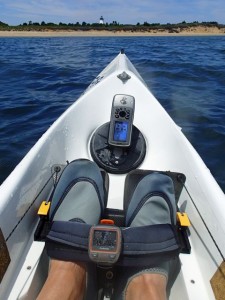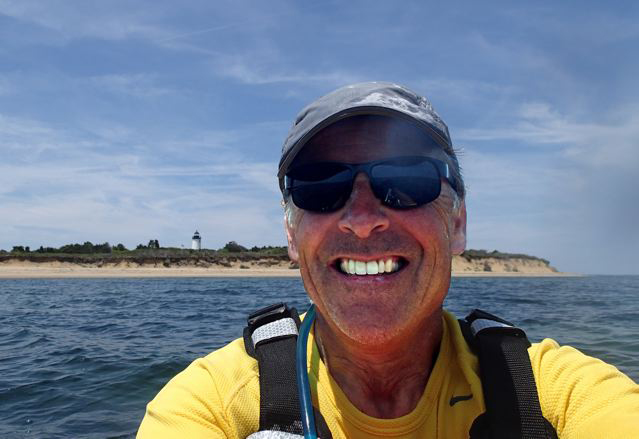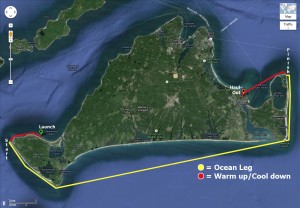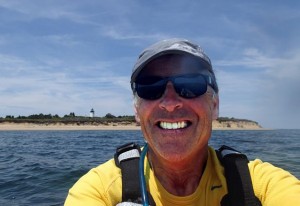Most of us who enjoying kayaking the waters of Martha’s Vineyard are content to stay on the great ponds or close to the Vineyard Sound or Atlantic shorelines. We go out for a pleasant hour or two of paddling, stopping often to watch the birds or peer into the watery depths below our boats.
Dana Gaines of Edgartown has a different approach. Take yesterday, for instance. After launching at 7:30 am from Dogfish Bar, he made his way around the Gay Head Cliffs (a warm-up, to him), and spent the next 5 hours paddling the whole western and southern lengths of Martha’s Vineyard, ending up on the beach at Edgartown’s Eel Pond.
Thirty-four miles, just a quick jaunt for Dana, but the trip was part of his training for a bigger challenge: a full circumnavigation of the island on August 9, to raise money for the rescue of the Gay Head Lighthouse. Unless moved to a more secure location, the lighthouse is in danger of toppling over the cliff-edge into the sea. Dana and many other islanders are involved in the effort to raise over $3 million for the move and restoration of the lighthouse.
Training for August 9th
Why this route, today? “I had originally intended to do the trip on Thursday, when the tide pattern would have mirrored that of August 9 and called for a 5AM start (tides run about one hour later each successive day),” Dana said. “But Thursday through Saturday had north/northeast winds, and I wanted a southwest
wind which would also mirror what will most likely be the case on Aug 9 . So tide/current conditions at the 7:30 am start yesterday were similar to what they’ll be at 5:00 am on August 9 — and the wind came up light southwest, which gave me a good sense of speed with a SW tailwind on the Atlantic leg (which added at least 1/2-mph to my normal forward speed).”
Roaring Around the Chops
How do you plan a trip like this so far from the launch date? According to Dana, “You can plan precisely as far as what the tidal currents will be doing– that data is readily available via the Eldridge Tide Book. For this particular route, I need a tide that’s flooding (rising) starting in the early morning, and ebbing (dropping) after 11AM. As long as I can maintain my projected paddling speed, I can therefore position myself to take maximum advantage of the strong currents which run up and down Vineyard Sound, and roar around the two Chops, easily gaining 2 mph of forward speed. Conversely, if I fall behind and get caught by a current change, it’s like paddling on a treadmill, making 3.5 mph forward speed rather than the normal 5.5, and with increased effort. August 9 has the right tide times, although a bit earlier than ideal, necessitating a 5AM start if the route is counterclockwise).”
But surely you can’t predict the wind? “Of course, wind direction and speed on that day are completely unpredictable– but on average, in August the wind blows light out of the southwest in the morning, strengthening in the afternoon. I’m basing most of the planning on that– but working out scenarios for every other direction as well.
What would make you decide to postpone the trip? “Any forecast in excess of 18 knots wind speed will abort to the next day– it can get too challenging out there, and the concern is not to be capsizing when exhausted in the latter stages of the trip.”
Type One Diabetes On the Water
As a paddler with type one diabetes, how do you manage your condition while on the water? “I reduce dosages of both 24-hour time release, and fast-acting insulin to minimal levels; when burning calories as continuously as I do in a continuous effort over many hours, the metabolism of food-to-energy becomes extra efficient, and I can get by with minimal amounts of insulin (insulin serves the critical function of transporting glucose out of the bloodstream and into the cells, which burn it for energy; since my pancreas no longer makes any insulin, I need to calculate food intake and energy output, and inject a commensurate amount of synthetic insulin to cover for what my body can’t produce on its own).”
Close Calls
The sea is a dangerous place for anyone, but for a diabetic it must be even more challenging. Have you ever had any dodgy moments in your kayak? “Two
capsizes in past years due to hypoglycemia, or low blood sugar; injected insulin doesn’t know when to shut off, so will continue dropping the blood sugar way below low normal if more food isn’t taken in; and since glucose is the primary fuel for the brain, a low level leads to confusion and poor balance– not good things in a kayak.”
“On balance, it’s simply safer to always err on the side of caution and take in an excess of food during lengthy athletic events– there’s no short-term danger to the glucose level being higher than normal, so keeping it around 180 will be my goal (testing is difficult to do out on the water, but I plan to work on that and perhaps check glucose levels at each 2-hour food stop). Both capsizes were mercifully in shallow water, where I could touch– and hitting the water was enough to bring me to my senses and eat a few glucose tablets which I always carry for such an occasion.”


